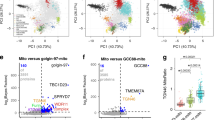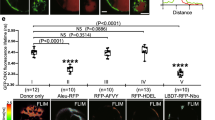Abstract
The biogenesis and maintenance of asymmetry is crucial to many cellular functions including absorption and secretion, signalling, development and morphogenesis. Here we have directly visualized the segregation and trafficking of apical (glycosyl phosphatidyl inositol-anchored) and basolateral (vesicular stomatitis virus glycoprotein) cargo in living cells using multicolour imaging of green fluorescent protein variants. Apical and basolateral cargo segregate progressively into large domains in Golgi/trans-Golgi network structures, exclude resident proteins, and exit in separate transport containers. These remain distinct and do not merge with endocytic structures suggesting that lateral segregation in the trans-Golgi network is the primary sorting event. Fusion with the plasma membrane was detected by total internal reflection microscopy and reveals differences between apical and basolateral carriers as well as new 'hot spots' for exocytosis.
This is a preview of subscription content, access via your institution
Access options
Subscribe to this journal
Receive 12 print issues and online access
$209.00 per year
only $17.42 per issue
Buy this article
- Purchase on Springer Link
- Instant access to full article PDF
Prices may be subject to local taxes which are calculated during checkout








Similar content being viewed by others
References
Ikonen, E. & Simons, K. Protein and lipid sorting from the trans-Golgi network to the plasma membrane in polarized cells. Semin. Cell Dev. Biol. 9, 503–509 (1998).
Yeaman, C., Grindstaff, K. K. & Nelson, W. J. New perspectives on mechanisms involved in generating epithelial cell polarity. Physiol. Rev. 79, 73–98 (1999).
Simons, K. et al. Biogenesis of cell-surface polarity in epithelial cells and neurons . Cold Spring Harb. Symp. Quant. Biol. 57, 611–619 (1992).
Winckler, B., Forscher, P. & Mellman, I. A diffusion barrier maintains distribution of membrane proteins in polarized neurons. Nature 397, 698–701 (1999).
Bretscher, M. S. Moving membrane up to the front of migrating cells. Cell 85, 465–467 (1996).
Traub, L. M. & Kornfeld, S. The trans-Golgi network: a late secretory sorting station. Curr. Opin. Cell Biol. 9 , 527–533 (1997).
Mostov, K. E. & Cardone, M. H. Regulation of protein traffic in polarized epithelial cells. BioEssays 17, 129–138 (1995).
Müsch, A., Xu, H., Shields, D. & Rodriguez-Boulan, E. Transport of vesicular stomatitis virus to the cell surface is signal mediated in polarized and nonpolarized cells. J. Cell Biol. 133, 543–558 (1996).
Yoshimori, T., Keller, P., Roth, M. G. & Simons, K. Different biosynthetic transport routes to the plasma membrane in BHK and CHO cells. J. Cell Biol. 133, 247–256 (1996).
Keller, P. & Simons, K. Post-Golgi biosynthetic trafficking . J. Cell Sci. 110, 3001– 3009 (1997).
Mellman, I. et al. Molecular sorting in polarized and non-polarized cells: common problems, common solutions. J. Cell Sci. 17 (Suppl.), 1–7 (1993).
Matter, K. & Mellman, I. Mechanisms of cell polarity: sorting and transport in epithelial cells. Curr. Opin. Cell Biol. 6, 545–554 (1994).
Fölsch, H., Ohno, H., Bonifacino, J. S. & Mellman, I. A novel clathrin adaptor complex mediates basolateral targeting in polarized epithelial cells. Cell 99, 189– 198 (1999).
Scheiffele, P. & Simons, K. in Epithelial Morphogenesis in Development and Disease (eds Birchmeier, W. & Birchmeier, C.) 41–71 (Harwood Academic, Newark, New Jersey, 1999).
Rodriguez-Boulan, E. & Gonzalez, A. Glycans in post-Golgi apical targeting: sorting signals or structural props? Trends Cell. Biol. 9, 291–294 ( 1999).
Simons, K. & Ikonen, E. Functional rafts in cell membranes . Nature 387, 569–572 (1997).
Rindler, M. J., Ivanov, I. E., Plesken, H., Rodriguez-Boulan, E. & Sabatini, D. D. Viral glycoproteins destined for apical or basolateral plasma membrane domains traverse the same Golgi apparatus during their intracellular transport in doubly infected Madin–Darby canine kidney cells. J. Cell Biol. 98, 1304 –1319 (1984).
Fuller, S. D., Bravo, R. & Simons, K. An enzymatic assay reveals that proteins destined for the apical or basolateral domains of an epithelial cell line share the same late Golgi compartments. EMBO J. 4, 297– 307 (1985).
Griffiths, G. & Simons, K. The trans Golgi network: sorting at the exit site of the Golgi complex. Science 234, 438–443 (1986).
Hirschberg, K. et al. Kinetic analysis of secretory protein traffic and characterization of Golgi to plasma membrane transport intermediates in living cells. J. Cell Biol. 143, 1485–1503 (1998).
Nakata, T., Terada, S. & Hirokawa, N. Visualization of the dynamics of synaptic vesicle and plasma membrane proteins in living axons. J. Cell Biol. 140, 659–674 (1998).
Toomre, D., Keller, P., White, J., Olivo, J. C. & Simons, K. Dual-color visualization of trans-Golgi network to plasma membrane traffic along microtubules in living cells. J. Cell Sci. 112, 21–33 ( 1999).
Toomre, D., Steyer, J. A., Keller, P., Almers, W. & Simons, K. Fusion of constitutive membrane traffic with the cell surface observed by evanescent wave microscopy. J. Cell Biol. 149, 33–40 (2000).
Miyawaki, A. et al. Fluorescent indicators for Ca2+ based on green fluorescent proteins and calmodulin. Nature 388, 882–887 (1997).
Röttger, S. et al. Localization of three human polypeptide GalNAc-transferases in HeLa cells suggests initiation of O-linked glycosylation throughout the Golgi apparatus. J. Cell Sci. 111, 45 –60 (1998).
Storrie, B. et al. Recycling of Golgi-resident glycosyltransferases through the ER reveals a novel pathway and provides an explanation for nocodazole-induced Golgi scattering. J. Cell Biol. 143, 1505 –1521 (1998).
Girotti, M. & Banting, G. TGN38-green fluorescent protein hybrid proteins expressed in stably transfected eukaryotic cells provide a tool for the real-time, in vivo study of membrane traffic pathways and suggest a possible role for ratTGN38. J. Cell Sci. 109, 2915–2926 (1996).
Füllekrug, J. et al. Localization and recycling of gp27 (hp24γ3): Complex formation with other p24 family members. Mol. Biol. Cell 10, 1939–1955 (1999).
Leitinger, B., Hille-Rehfeld, A. & Spiess, M. Biosynthetic transport of the asialoglycoprotein receptor H1 to the cell surface occurs via endosomes. Proc. Natl Acad. Sci. USA 92, 10109–10113 ( 1995).
Futter, C. E., Connolly, C. N., Cutler, D. F. & Hopkins, C. R. Newly synthesized transferrin receptors can be detected in the endosome before they appear on the cell surface. J. Biol. Chem. 270 , 10999–11003 (1995).
Axelrod, D. Cell–substrate contacts illuminated by total internal reflection fluorescence . J. Cell Biol. 89, 141– 145 (1981).
Schmoranzer, J., Goulian, M., Axelrod, D. & Simon, S. M. Imaging constitutive exocytosis with total internal reflection fluorescence microscopy. J. Cell Biol. 149, 23–31 (2000).
Harder, T., Scheiffele, P., Verkade, P. & Simons, K. Lipid domain structure of the plasma membrane revealed by patching of membrane components. J. Cell Biol. 141, 929– 942 (1998).
Benting, J. H., Rietveld, A. G. & Simons, K. N–Glycans mediate the apical sorting of a GPI-anchored, raft-associated protein in Madin–Darby canine kidney cells. J. Cell Biol. 146, 313– 320 (1999).
Füllekrug, J., Scheiffele, P. & Simons, K. VIP36 localisation to the early secretory pathway. J. Cell Sci. 112, 2813–2821 (1999).
Dell'Angelica, E. C., Mullins, C. & Bonifacino, J. S. AP-4, a novel protein complex related to clathrin adaptors. J. Biol. Chem. 274, 7278– 7285 (1999).
Ladinsky, M. S., Kremer, J. R., Furcinitti, P. S., McIntosh, J. R. & Howell, K. E. HVEM tomography of the trans-Golgi network: structural insights and identification of a lace-like vesicle coat. J. Cell Biol. 127, 29– 38 (1994).
Ladinsky, M. S., Mastronarde, D. N., McIntosh, J. R., Howell, K. E. & Staehelin, L. A. Golgi structure in three dimensions: functional insights from the normal rat kidney cell. J. Cell Biol. 144, 1135–1149 ( 1999).
Hedman, K., Goldenthal, K. L., Rutherford, A. V., Pastan, I. & Willingham, M. C. Comparison of the intracellular pathways of transferrin recycling and vesicular stomatitis virus membrane glycoprotein exocytosis by ultrastructural double-label cytochemistry. J. Histochem. Cytochem. 35, 233–243 (1987).
Grindstaff, K. K. et al. Sec6/8 complex is recruited to cell–cell contacts and specifies transport vesicle delivery to the basal–lateral membrane in epithelial cells. Cell 93, 731– 740 (1998).
Mantei, N. et al. Complete primary structure of human and rabbit lactase-phlorizin hydrolase: implications for biosynthesis, membrane anchoring and evolution of the enzyme. EMBO J. 7, 2705– 2713 (1988).
Seed, B. An LFA-3 cDNA encodes a phospholipid-linked membrane protein homologous to its receptor CD2. Nature 329, 840– 842 (1987).
Harrison, P. T., Hutchinson, M. J. & Allen, J. M. A convenient method for the construction and expression of GPI-anchored proteins. Nucleic Acids Res. 22, 3813–3814 (1994).
He, T. C. et al. A simplified system for generating recombinant adenoviruses. Proc. Natl Acad. Sci. USA 95, 2509– 2514 (1998).
Laemmli, U. K. Cleavage of structural proteins during the assembly of the head of bacteriophage T4. Nature 227, 680–685 (1970).
White, J. et al. Rab6 coordinates a novel Golgi to ER retrograde transport pathway in live cells. J. Cell Biol. 147, 743– 759 (1999).
Diggle, P. J. Statistical Snalysis of Spatial Point Patterns (Academic, London, 1983).
Acknowledgements
We acknowledge Olympus and TILL Photonics for providing equipment and support to the Advanced Light Microscope Facility at EMBL; J. Rietdorf and R. Pepperkok for technical support; R. Tsien and G. Banting for ECFP and TGN38–EGFP cDNA, respectively; and N. LeBot and J. Füllekrug for GFP and gp27 antibodies, respectively. J. Ellenberg, G. Griffiths and R. Pepperkok are acknowledged for critical comments on the manuscript. P.K. was supported by a grant from the Max Plank Gesellschaft, D.T. by a Marie Curie Research grant, E.D. by a grant from the Secretaría de Estado de Educación, Universidades, Investigación y Desarollo, and K.S. by an EU network grant and a grant from the Deutsche Forschungsgemeinschaft. Supplementary Information is available on http://www.mpi-cbg.de/content.php3?lang=en&aktID=videos8.
Author information
Authors and Affiliations
Corresponding author
Rights and permissions
About this article
Cite this article
Keller, P., Toomre, D., Díaz, E. et al. Multicolour imaging of post-Golgi sorting and trafficking in live cells . Nat Cell Biol 3, 140–149 (2001). https://doi.org/10.1038/35055042
Received:
Revised:
Accepted:
Published:
Issue Date:
DOI: https://doi.org/10.1038/35055042
This article is cited by
-
Membrane phase separation drives responsive assembly of receptor signaling domains
Nature Chemical Biology (2023)
-
Structure Composition and Intracellular Transport of Clathrin-Mediated Intestinal Transmembrane Tight Junction Protein
Inflammation (2023)
-
Broadband self-powered photodetection with p-NiO/n-Si heterojunctions enhanced with plasmonic Ag nanoparticles deposited with pulsed laser ablation
Journal of Materials Science: Materials in Electronics (2022)
-
Regression Analysis of Confocal FRAP and its Application to Diffusion in Membranes
Journal of Fluorescence (2022)
-
A lipid-based partitioning mechanism for selective incorporation of proteins into membranes of HIV particles
Nature Cell Biology (2019)



